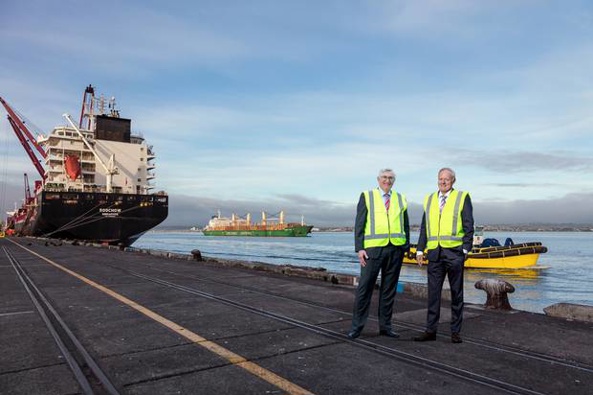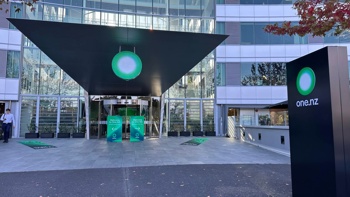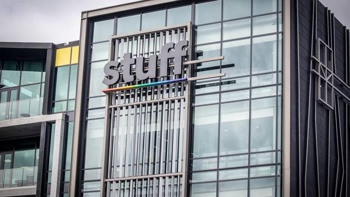Port of Tauranga has posted group net profit of $90 million and increased container volumes, despite the pandemic storm that lashed global shipping and trade in the final months of its financial year.
New Zealand's largest port said net profit after tax was $10.6m down on the previous year while revenue also fell to $302m from $313m as log exports slumped by nearly 22 per cent and imports and exports were buffeted by the global Covid virus.
The company will pay a final dividend of 6.4c a share but has suspended the special dividend scheme to reserve funds to accelerate capital expenditure for growth.
The full year dividend is 12.4c a share, 90 per cent of underlying net profit after tax. The average annual compounding total shareholder return has been 23.34 per cent over the past 10 years, the company said.
Container volumes increased 1.5 per cent to total 1,251,741 for the year ended June 30.
Also up, by 18.5 per cent, were earnings from subsidiary and associate companies at $14.1m. Group ebitda fell 8.1 per cent to $166.5m.
Total trade of 24.8m tonnes was slightly down on FY19's 26.9m tonnes.
Exports decreased 8 per cent to 15.8m tonnes and imports fell 7.8 per cent to 9m tonnes as NZ Inc. struggled to keep business flowing in local and international Covid shutdowns.
Log export volumes were squeezed in the first half of the financial year by lower international prices and demand. By March positive signs were emerging from New Zealand's main log market China as business there returned to normal after Covid shutdown disruption, but then forestry was deemed a non-essential industry during New Zealand's level 4 response. Logs already on the Tauranga wharves could be shipped but it was May before trucks could start bringing in fresh supply.
Overall log volumes fell 21.5 per cent to 5.5m tonnes.
Dairy exports increased 1.7 per cent to nearly 2.4m tonnes and meat exports surged by 15.4 per cent.
Kiwifruit exports held steady with a continuing trend to containerisation.
Transhipped containers remained nearly a third of total containers handled. Transhipment is when containers are transferred from one ship to another.
Highlights included a 15.3 per cent reduction in the port's overall carbon emissions and the company's land and buildings portfolio value swelling by $43.5m.
The port remains Australasia's most productive container terminal with the average net crane rate increasing 8.8 per cent to 35.8 moves per hour.
Chairman David Pilkington said the pandemic impacts included shipping cancellations, reduced cargo volumes, operational challenges and increased costs, with a resulting economic recession in New Zealand and overseas.
"We are better positioned than most, due to our track record of strong capital discipline, our conservative balance sheet and capacity headroom," he said.
"Our diversity of cargo gives us some resilience in terms of revenue, while the strength of our people and processes has really shone through in keeping New Zealand's most efficient port operating."
Chief executive Mark Cairns said the port was now planning for the next stage of cargo growth in response to customer demand. It would add another container vessel berth to the south of the Sulphur Point wharves. A ninth container crane had been introduced during the year.
The port team had put in an "outstanding performance" to keep essential imports and exports flowing through the Covid lockdown.
Cairns said the short and medium term impacts of the pandemic were still uncertain.
"We expect cargo volumes to slowly recover over the next three years, with dairy product and kiwifruit exports likely to be the strongest performers in terms of growth.
"We are still confident of growth over the long term and given the lead time required for any investment, we continue to pursue capacity expansion.
"Our track record means we have a strong credit rating and we believe we are well-placed to weather the Covid 19 storm."
The company will provide an update on first quarter trade, and earnings guidance for the full year at the annual meeting on October 30.
Port of Tauranga operates wharves in Tauranga, Mount Maunganui and Timaru, as well as MetroPort Auckland, a rail-linked inland port in South Auckland and MetroPort Christchurch, an intermodal freight hub at Rolleston.
The group includes 100 per cent-owned Quality Marshalling, 50 per cent-owned Coda, a freight logistics company, 50 per cent-owned Northport, 50 per cent-owned PrimePort Timaru and the Timaru Container Terminal, and 50 per cent-owned Port Connect, an online cargo management system.










